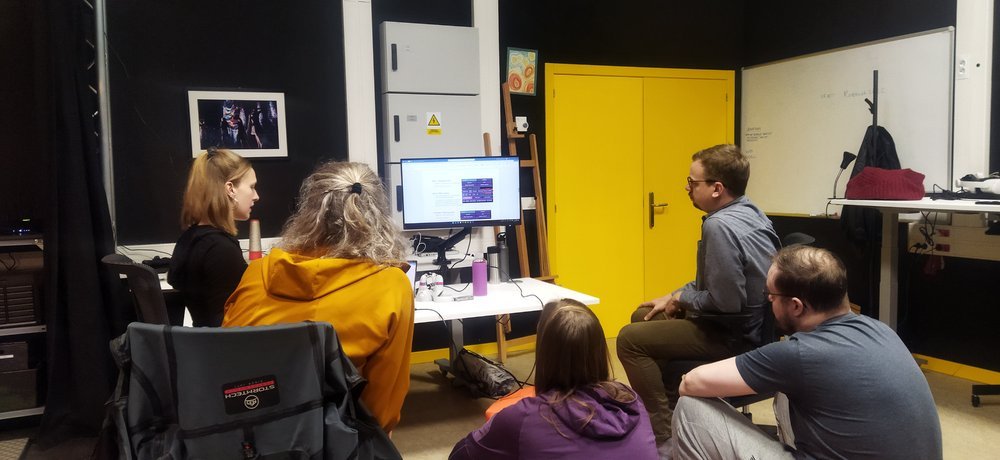




Sign up to our VR study 2.0!
Sign up now to take part in our study where you will interact with real-time molecular simulations in virtual reality! This study is open to everyone, no prior experience required.



Presenting at the International Conference on Extended Reality 2024
Our PhD candidate, Rhoslyn Roebuck Williams, attended the International Conference on eXtended Reality to present the results of our pilot study investigating the threshold at which we can sense the properties of interactive molecular simulations in VR!

SubtleGame: Partnering with our Bristol ‘node’
This July we visited our collaborators in the School of Chemistry at the University of Bristol (UK) in the lab of Professor Adrian Mulholland. During our visit, we collected data for our ongoing project using Subtle Game, a single-person gamified version of our iMD-VR software, NanoVer.

SubtleGame: pilot study at our Bologna ‘node’
In March, our team had the opportunity to visit one of our 'VR nodes' located within the laboratory of Associate Professor Emanuele Paci at the Department of Physics, University of Bologna. This visit marks the beginning of our data collection phase for our pioneering research into sensing the properties of interactive molecular simulations in virtual reality.
Third-party development: eye-tracking in Narupa iMD
A group of researchers in Russia implemented eye tracking in Narupa iMD and published their results in the Journal of Chemical Education last December.

Modernising Narupa
The Narupa software framework is at the core of many projects in the lab. This software stack is what allows us to do multi-user interactive molecular dynamics in Virtual Reality. The main elements are the server and the Narupa iMD VR client. The server drives the molecular simulation, sends the trajectory that is generated to the clients in real-time, and synchronises data such as the avatar positions amongst the clients. The Narupa iMD client connects to the server from which it receives the frames from the simulation to display in Virtual Reality. We are actively working on the Narupa framework.

Ciencia Singular 2023: dance with particles and BECOME a computational chemist
We open our lab doors to the general public today as part of the Ciencia Singular Day! Come and try out the installations we have to offer…

Nanover Mixed Reality Filming Day
Spent the day in the CiTIUS Maker Space creating some awesome mixed reality videos to show off Nanover, our open-source software for performing interactive molecular simulations in virtual reality.
Check out our new videos to see what Nanover can do! Multi-person VR, a variety of molecular systems, and some cool visualisations…

Molecular MARTINI
Molecular simulations can be computationally expensive. As we increase their length and time scales, running simulations becomes increasingly slow or requires increasingly more resources. Improved software and hardware reduce the cost, but these are not the only ways. Another way is to use a less expensive model. The Martini force field is such a model, and I have been involved in some of its recent developments.

Rhoslyn Roebuck Williams on ‘Alternatives to Physical Touch When Interacting With Molecular Simulations in VR’
A presentation by PhD student Rhoslyn Roebuck Williams on her research on sensing molecular simulations in virtual reality.

Free energy along drug-protein binding pathways interactively sampled in virtual reality
We develop tools to view and interact with molecular simulations in Virtual Reality (VR). These tools let us see molecular systems in a different light to get a new intuition for them. In particular, it gives us a sense of how 3-dimensional and dynamic these systems are. So far, we have mostly gained qualitative insight into the biology and chemistry questions we had about molecular systems. Our new article, in collaboration with the University of Bristol and the University of Valencia, presents a new way to use trajectory generated in Virtual Reality as a base to compute free energies and get quantitative insight.


![[IRL x ispace] molecular Sensing workshop + Open Lab](https://images.squarespace-cdn.com/content/v1/61572c652b49f51af8aa637b/1681135072311-Q59W0QAE5573QJ5ARBFM/openlab+flyer+final.jpg)
[IRL x ispace] molecular Sensing workshop + Open Lab
For the week 17–21 April, The IRL will host visiting researchers from the iSpaceLab from Simon Fraser University in Vancouver. The iSpaceLab have expertise in designing and investigating VR experiences that make a positive impact on individuals and society.
At the Open Lab we will showcase several of the interactive and immersive experiences designed by our labs as a way of starting conversations about how we interact with + touch digital worlds, and how these strategies might furnish researchers with new ways to understand otherwise invisible microscopic and molecular realities
